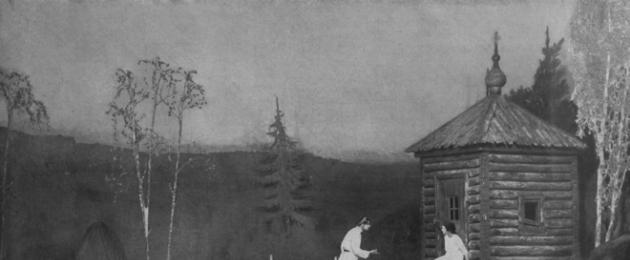




Konstantin Stanislavsky as Gaev. Production of "The Cherry Orchard" at the Moscow Art Theater. 1904 year
Leonid Leonidov as Lopakhin. Production of "The Cherry Orchard" at the Moscow Art Theater. 1904 year© Album "Plays of A. P. Chekhov". Supplement to the magazine "Solntse Rossii", No. 7, 1914
Alexander Artyom as Firs. Production of "The Cherry Orchard" at the Moscow Art Theater. 1904 year© Album "Plays of A. P. Chekhov". Supplement to the magazine "Solntse Rossii", No. 7, 1914
Vasily Katchalov as Petit Trofimov and Maria Lilina as Ani. Production of The Cherry Orchard at the Moscow Art Theater, Act II. 1904 year © Album "Plays of A. P. Chekhov". Supplement to the magazine "Solntse Rossii", No. 7, 1914
Firs: "They left ... They forgot about me." Production of "The Cherry Orchard" at the Moscow Art Theater, Act IV. 1904 year© Album "Plays of A. P. Chekhov". Supplement to the magazine "Solntse Rossii", No. 7, 1914
Cotillion. Production of The Cherry Orchard at the Moscow Art Theater, Act III. 1904 year© Album "Plays of A. P. Chekhov". Supplement to the magazine "Solntse Rossii", No. 7, 1914
In this very first production of The Cherry Orchard, Chekhov did not like a lot. The author's discrepancies with Konstantin Stanislavsky, who staged a play written specifically for the Moscow Art Theater, concerned the distribution of roles between performers, mood and genre (Stanislavsky was convinced that he was staging a tragedy), even staging means reflecting the naturalistic aesthetics of the early Moscow Art Theater. “I will write a new play, and it will begin like this: 'How wonderful, how quiet! There are no birds, no dogs, no cuckoos, no owls, no nightingales, no clocks, no bells and not a single cricket, ”Stanislavsky quoted Chekhov's snide joke about the sound score that recreates estate life. Today not a single Chekhov biography or history of the Moscow Art Theater bypasses this conflict between the writer and the theater. But the oppressive atmosphere, streams of tears and everything that frightened Chekhov is at odds with the few surviving fragments of later versions of The Cherry Orchard - a performance that remained in the theater's repertoire until the second half of the 1930s and was constantly changing, including thanks to the very Stanislavsky. For example, with a short final scene with Firs recorded on film: the voice of a footman performed by Mikhail Tarkhanov resounds in it - despite the situation of a forgotten servant in the house, how hard every movement is given to this decrepit old man, in spite of everything - suddenly unusually young. Just now, Ranevskaya, sobbing, said goodbye to her youth on stage, and she miraculously returned to Firs in these very last minutes.
1954 year. "Company Renault - Barrot", Paris. Director - Jean Louis Barrot
![]()



Scene from Jean Louis Barrot's production The Cherry Orchard. Paris, 1954© Manuel Litran / Paris Match Archive / Getty Images
Scene from Jean Louis Barrot's production The Cherry Orchard. Paris, 1954© Manuel Litran / Paris Match Archive / Getty Images
Scene from Jean Louis Barrot's production The Cherry Orchard. Paris, 1954© Manuel Litran / Paris Match Archive / Getty Images
Outstanding European productions of The Cherry Orchard began to appear only after the war. Theater historians explain this by the extremely strong impression of Western directors from the Moscow Art Theater performance, which has taken Chekhov's play on tour more than once. The Cherry Orchard, staged by Jean Louis Barrot, did not become a breakthrough, but it is a very interesting example of how the European theater, in search of its own Chekhov, slowly emerged from the influence of the Moscow Art Theater. From the director Barrot, who in these years discovered for himself and the audience of his theater Camus and Kafka, who continued to stage his main author, Claudel, one could expect Chekhov to be read through the prism of the newest theater. But there is nothing of this in Barro's "Cherry Orchard": listening to the surviving recording of his radio broadcast, you remember about absurdism only when Gaev, in response to Lopakhin's business proposal about arranging dachas on the site of the estate, is outraged: "Absurde!" The Cherry Orchard staged by the Renault Barrot Company is first of all (and strictly according to Chekhov) a comedy, in which a huge place was allotted to music. Pierre Boulez, with whom the theater collaborated during these years, was responsible for her in the play. The role of Ranevskaya was played by Barrot's wife, the co-founder of the theater, who earned her fame as a comic actress "Comedie Francaise", Madeleine Reno. And Barro himself unexpectedly chose for himself the role of Petya Trofimov: perhaps the great mime was close to the hero who deciphered the character of the merchant Lopakhin by his hands - "gentle fingers, like an artist."
1974 year. Teatro Piccolo, Milan. Director - Giorgio Strehler



Rehearsal of the play "The Cherry Orchard" by Giorgio Strehler. Milan, 1974© Mondadori Portfolio / Getty Images
Tino Carraro directed by Giorgio Strehler "The Cherry Orchard"
Tino Carraro and Enzo Tarasho, directed by Giorgio Strehler "The Cherry Orchard"© Mario De Biasi / Mondadori Portfolio / Getty Images
“Craig wants the set to be as fluid as music and help to perfect certain places in a piece, just as with music it is possible to follow the turns of the action and emphasize them. He wants the scenery to change with the play, ”wrote artist Rene Pio in 1910 after meeting with the English director and set designer Gordon Craig. The scenery by Luciano Damiani in The Cherry Orchard directed by Giorgio Strehler, due to its striking simplicity, has become perhaps the best example of this way of working with space in modern theater. Above the snow-white stage, a wide, in the entire depth of the stage, a translucent curtain was stretched, which at different moments quietly swayed over the heroes, then dropped dangerously low over them, then sprinkled them with dry leaves. The scenery turned into a partner for the actors, and they themselves were reflected in their own way in very few objects on the stage, like children's toys taken from a century-old closet. The plastic score of Ranevskaya, played by the actress Valentina Cortese for Strehler, was based on rotation, and the top launched by Gayev rhymed with this movement, spinning for a minute and then suddenly flying off its axis.
1981 year. Theater "Buff-du-Nord", Paris. Director - Peter Brook


The Cherry Orchard by Peter Brook at the Buff-du-Nord Theater. 1981 year© Nicolas Treatt / archivesnicolastreatt.net
In his lectures on the history of literature, Naum Berkovsky called the subtext the language of enemies, and connected its appearance in the drama with the changing relationships of people at the beginning of the 19th century. In The Cherry Orchard by Peter Brook, the characters have no enemies among each other. The director did not have them in the play either. And the subtext in Chekhov's work suddenly radically changed its quality, ceased to be a method of concealment, but, on the contrary, turned into a means of revealing to each other that which cannot be conveyed with the help of words. Played with little or no decorations (the walls and floors of the old Parisian theater "Buff-du-Nord" were covered with carpets), this performance was closely associated with post-war literature: “Chekhov writes extremely succinctly, using a minimum of words, and his writing style is reminiscent of Pinter or Beckett - said Brooke in an interview. "For Chekhov, like them, composition, rhythm, purely theatrical poetry of the only exact word, pronounced then and in the right way, plays a role." Among the countless, still emerging interpretations of The Cherry Orchard as a drama of absurdity, perhaps the most unusual thing in Brook's performance was precisely the fact that, read through Beckett and Pinter, his Chekhov sounded in a new way, but remained himself.
2003 year. Stanislavsky International Foundation and Meno Fortas Theater, Vilnius. Director - Eimuntas Nyakrosius


The play "The Cherry Orchard" by Eimuntas Nyakrosius. Festival "Golden Mask". Moscow, 2004
Evgeny Mironov as Lopakhin in the play "The Cherry Orchard" by Eimuntas Nyakrosius. Festival "Golden Mask". Moscow, 2004 © Dmitry Korobeinikov / RIA Novosti
The first thing that the audience saw on the stage was the garments of the inhabitants of the house thrown on top of each other, standing behind low columns, two hoops coming from nowhere: a seemingly manor house, but as if reassembled from almost random objects. In this "Cherry Orchard" there were references to Strehler, but there was not even a trace of the poetry of the Italian Chekhovian performance. However, the performance of Nyakrosius itself was built rather according to the laws of a poetic text. The six hours he walked, connections between things, gestures (as always with Nyakrosius, an unusually rich plastic score), sounds (like the unbearably loud cry of swallows) and music, unexpected animal parallels of the heroes - these connections multiplied at an extraordinary speed, permeating all levels ... “A gloomy and splendid bulk,” wrote the theater expert Pavel Markov about Meyerhold's “The Inspector General,” and this is exactly what the impression of the play by the Lithuanian director staged together with Moscow artists for the centenary of Chekhov's
plays.
- In contact with 0
- Google+ 0
- OK 0
- Facebook 0








